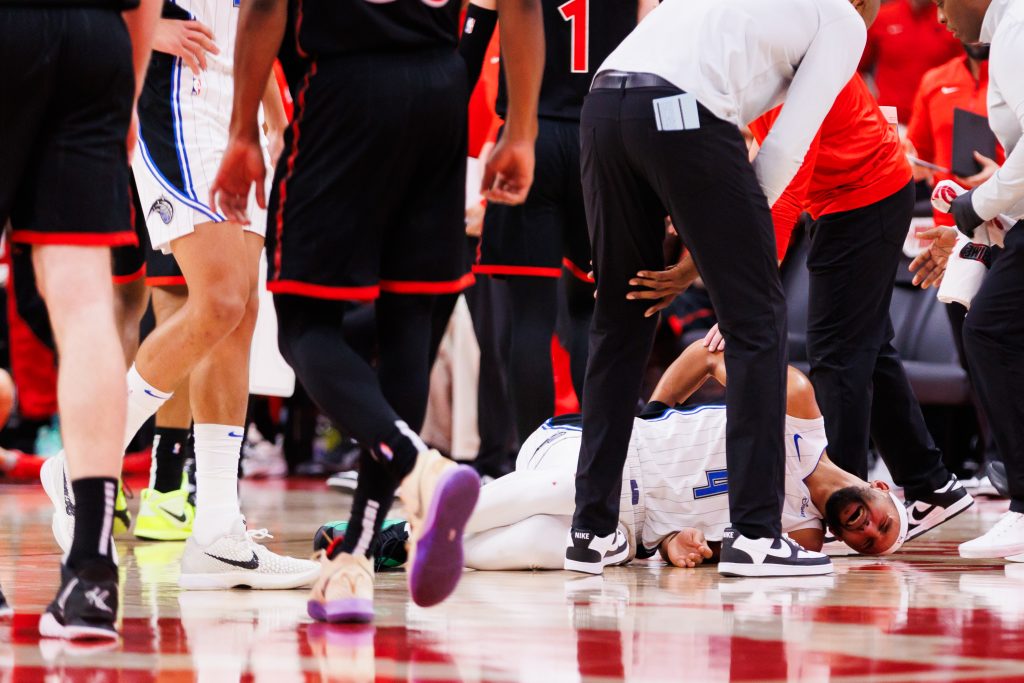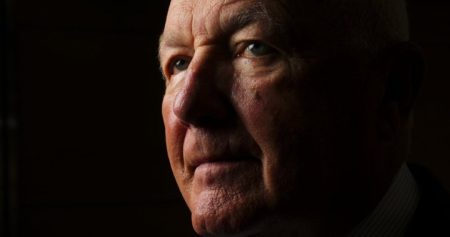Jalen Suggs’ Non-Contact Injury: A Detailed Account and Analysis
On January 4, 2025, during a game between the Orlando Magic and the Toronto Raptors at Scotiabank Arena, Orlando Magic guard Jalen Suggs suffered a frightening non-contact injury that sent him off the court in a wheelchair. The incident occurred during a defensive play when Suggs, attempting to contest a play, made a sudden leap towards the ball. Without any contact from another player, he landed awkwardly and immediately collapsed to the floor, clutching his lower back in apparent pain. The sudden nature of the injury and Suggs’ immediate reaction caused concern among players, coaches, and fans alike.
The game was briefly paused as medical personnel attended to Suggs on the court. He was clearly in distress, unable to put weight on his legs. The somber silence in the arena emphasized the gravity of the situation. After a few minutes of assessment and initial treatment, Suggs was helped into a wheelchair and transported off the court. The fans at Scotiabank Arena, despite witnessing an injury to an opposing player, showed their respect and concern with applause as Suggs exited. This gesture of sportsmanship highlighted the universal concern for player safety that transcends team loyalties.
The Orlando Magic public relations team quickly provided an update via social media, confirming that Suggs would not return to the game due to back spasms. Before exiting the game, Suggs had contributed six points, one rebound, and one assist in just 13 minutes of playing time. While the immediate diagnosis of back spasms provided some initial relief, the severity and long-term implications of the injury remained uncertain at that time. Further evaluation and medical imaging would be necessary to determine the full extent of the injury and the appropriate course of treatment.
Understanding Back Spasms and Their Implications in Sports
Back spasms, while commonly associated with minor muscle strains, can range in severity and can be debilitating for athletes. They occur when muscles in the back contract involuntarily, causing sudden and intense pain. Various factors can contribute to back spasms, including overuse, muscle fatigue, dehydration, and sudden movements or strains. In athletes, the repetitive stress and high-impact nature of sports can make them particularly susceptible to this type of injury. While often short-lived, back spasms can sometimes indicate a more serious underlying condition, such as a herniated disc or spinal stenosis. Therefore, a thorough medical evaluation is crucial to determine the cause and rule out any potential complications.
The impact of back spasms on an athlete’s performance can be significant. The pain and limited range of motion can restrict movement and hinder their ability to participate in training and competition. The recovery time for back spasms varies depending on the severity and underlying cause, ranging from a few days to several weeks. Treatment typically involves rest, ice, heat therapy, pain medication, and physical therapy to strengthen the back muscles and improve flexibility. In some cases, more invasive treatments, such as injections or surgery, may be necessary.
Jalen Suggs’ Injury: Potential Impact and the Road to Recovery
For Jalen Suggs, this back injury adds another setback to a career that has already been hampered by injuries. His ability to stay healthy and contribute consistently will be crucial for the Orlando Magic’s success. Suggs’ athleticism and playmaking abilities are vital to the team’s offensive and defensive schemes. His absence, even for a short period, would be felt on the court. The Magic organization, coaching staff, and medical team will undoubtedly prioritize his recovery and ensure he receives the best possible care to facilitate a safe and effective return to play.
Suggs’ injury serves as a reminder of the inherent risks involved in professional sports. Even without contact from opponents, athletes are vulnerable to sudden and unpredictable injuries. The demanding physical nature of basketball, with its constant jumping, twisting, and cutting movements, puts significant stress on players’ bodies. This underscores the importance of proper training, conditioning, and injury prevention strategies. Teams and athletes must prioritize injury prevention programs that focus on strengthening core muscles, improving flexibility, and promoting proper biomechanics to minimize the risk of injuries like back spasms.
The news of Suggs’ injury resonated throughout the NBA community, sparking discussions about player safety and the importance of prioritizing long-term health over short-term gains. As the details of his injury and recovery timeline emerge, fans and analysts will be closely monitoring his progress and hoping for a swift and complete return to the court. Suggs’ determination, along with the support of his team and medical professionals, will be crucial in overcoming this setback and fulfilling his potential as a rising star in the NBA. His journey back to full health will be a testament to his resilience and dedication to the sport he loves.


![Who Is the Father of [Spoiler]’s Baby? Why ‘Ginny and Georgia’ Cast Remain ‘Divided’ Before Season 4](https://newsytribune.com/wp-content/uploads/2025/06/ginnygeorgiarecap-300x158.jpg)







